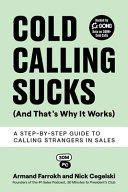

The book begins by addressing the common aversion to cold calling, framing it not as a dreaded chore but as an opportunity for genuine connection. The author emphasizes that reframing one's mindset about cold calling can transform it from a painful task into an engaging dialogue. By viewing cold calls as a chance to learn about potential clients and their needs, sales professionals can approach calls with curiosity and openness. This shift in perspective can reduce anxiety and improve the quality of conversations. The author provides practical strategies for making cold calls feel less intimidating, such as preparing open-ended questions that encourage dialogue, thus fostering a more authentic interaction.
Continue readingOne of the core tenets of successful cold calling is the ability to build rapport quickly. The book outlines techniques for establishing a connection with prospects, such as mirroring body language, using empathetic language, and finding common ground. The author argues that building rapport is essential for overcoming initial resistance and creating a comfortable atmosphere for discussion. By demonstrating genuine interest in the prospect's challenges and needs, salespeople can create a foundation of trust that can lead to more productive conversations. The book includes tips on how to listen actively and respond appropriately, reinforcing the importance of interpersonal skills in the sales process.
Continue readingThe author emphasizes the importance of asking the right questions during cold calls. Effective questioning can guide the conversation, uncover the prospect's pain points, and reveal opportunities for offering solutions. The book categorizes questions into open, closed, and probing types, explaining when and how to use each. Open questions encourage dialogue, closed questions can clarify specifics, and probing questions can delve deeper into issues. By mastering these techniques, sales professionals can navigate conversations more effectively, leading to better outcomes. The author provides examples of questions that can be used in various scenarios, making it easier for readers to implement these strategies in their own calls.
Continue readingObjections are a natural part of the sales process, and the author provides a framework for handling them gracefully. Instead of viewing objections as roadblocks, salespeople are encouraged to see them as opportunities to gain insight into the prospect's concerns. The book suggests techniques for addressing objections, such as acknowledging the concern, asking clarifying questions, and responding with tailored solutions. By approaching objections with empathy and understanding, sales professionals can turn potential rejections into productive discussions. The author also shares stories and examples of successful objection handling, illustrating how a positive approach can lead to favorable outcomes.
Continue readingPersistence is highlighted as a crucial element in successful cold calling. The author argues that many salespeople give up too soon after initial rejections, missing out on potential opportunities. The book discusses the importance of follow-ups and maintaining a consistent outreach strategy. By developing a systematic approach to follow-ups, sales professionals can keep the conversation alive and increase their chances of closing deals. The author shares insights on how to balance persistence with respect for the prospect's time and boundaries, ensuring that follow-ups are seen as valuable rather than intrusive. This mindset shift can lead to a more resilient and effective sales approach.
Continue readingIn today's digital age, technology plays a significant role in enhancing the cold calling process. The book explores various tools and platforms that can streamline outreach efforts, such as CRM systems, automated dialing software, and analytics tools. The author emphasizes the need for sales professionals to embrace technology to improve their efficiency and effectiveness. By leveraging data and insights gained from these tools, salespeople can tailor their approaches to better meet the needs of their prospects. The book provides practical tips on how to integrate technology into daily routines, making it easier to manage leads and track progress.
Continue readingFinally, the book discusses the importance of developing a personal brand as a sales professional. The author argues that a strong personal brand can enhance credibility and make cold calling more effective. By establishing a reputation for expertise and reliability, salespeople can create a sense of authority that attracts prospects. The book outlines strategies for building a personal brand, such as sharing knowledge through content creation, networking, and engaging with industry communities. The author emphasizes that a personal brand is not just about self-promotion but about providing value to others, which can lead to more meaningful connections and successful sales outcomes.
Continue reading